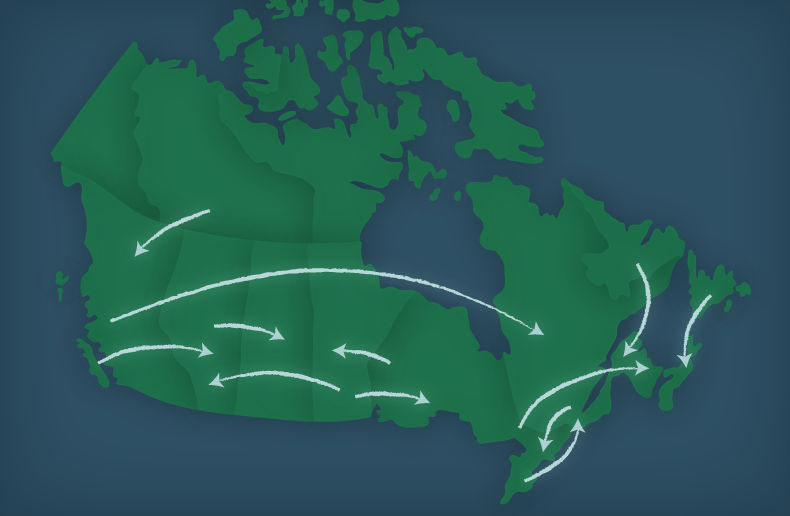At a time when transitory events are exacerbating year-long deep-rooted volatility triggered by COVID-19, investment professionals are forecasting an economic recovery in the second half of 2021 along with market opportunities.
In its 2021 outlook report, Capital Group analyzes and anticipates economic and financial movements for Canada, the United States, the Euro zone and emerging markets. The fund manager foresees the strongest economic recovery in 2021 in the euro zone and emerging markets. Capital Group believes that Europe and Asia will dominate in terms of innovation.
“Economic growth is making a comeback” on the macroeconomic level, Capital Group points out. The International Monetary Fund (IMF) estimates that global GDP will climb 5.2 per cent in 2021.” However, the group cautions that “risks to recovery remain, chief among them a resurgence of COVID-19.”
The IMF's forecast is widely supported, Swiss Re says. However, the international insurance banker estimates the global GDP increase at 4.8 per cent. In a recent edition of Economic Insights, the reinsurer notes dispersion in forecasts for U.S. growth in 2021, while 10-year yield forecasts are much more concentrated.
Beyond the 2021 rebound, Swiss Re expects the recovery to be protracted, creating a challenging macro environment, continued low interest rates and potentially higher inflation. “We believe the severity of the COVID-19 induced recession will have longstanding consequences for the global economy.”
COVID-19 has weighed on household and business balance sheets, the reinsurer continues. “The debt-to-GDP ratio of households and non-financial corporates had increased by about 20 percentage points (0.2per cent) by the third quarter of 2020,” Swiss Re says.
Reassuring vaccines
COVID-19 has been unremittingly fomenting financial market volatility for almost a year now, in addition to incurring record government debt and economic setbacks. “The natural world has a way of intervening from time to time to remind us just who’s in charge.” So begins Manulife Investment Management’s Global Knowledge newsletter for the first quarter of 2021.
Hope is on the horizon though. “The development and rollout of multiple vaccines in historic time increase the odds that 2021 will be a vast improvement over the year just ended,” Manulife Investment Management predicts.
This does not mean, however, a return to normal. Some of the changes will be lasting, says Frances Donald, Managing Director, Global Chief Economist and Global Head, Macroeconomic Strategy, at Manulife Investment Management. In particular, she mentions the blurring of the line between fiscal and monetary policy. This phenomenon “is one of the macro disruptors that have emerged from the pandemic and may endure well beyond its containment.”
Senior Vice President and Chief Economist of iA Financial Group, Clément Gignac,isweighing the pros and cons linked to COVID-19. Today it’s a bit of a tug-of-war between the good news of vaccination and the bad news about the virus mutation, he said in the iA economic review dated Jan. 29, 2021.
Canada lagging in vaccination rollout
Gignac thinks the pace of vaccination will strongly shape global GDPs. He cites IMF forecasts that China will have the strongest economic recovery by the end of 2021, with a GDP 10.7 percent higher than in late 2019. Also by the end of 2021, the United States will improve by 1.8 per cent compared with the pre-COVID era, while Canada will lag by 0.4 per cent, he adds.
He attributes Canada’s decline to the slowness of vaccination campaigns. Countries' economic growth will be closely linked to the speed of vaccination, Gignac predicts. He adds that the slower pace of vaccination in Canada than in the United States could leave its mark on economic data in the coming months.
In fact, vaccination campaigns are very uneven between countries, Gignac adds. In his economic review of Feb. 5, he backs this claim with a list of 23 countries ranked according to the number of single doses of COVID-19 vaccines administered per group of 100 people. In this ranking, based on data from ourworldindata.org, Canada places just ahead of France and far behind the United States. The world average at the time was 1.9 per cent.
Daily evolution
The situation is changing every day. As of Feb. 9, ourworldindata.org reported that France had a vaccination rate of 3.61 per cent, ahead of Canada (2.9 per cent). On that date, the vaccination leaders were: Israel (67.86 per cent), the United Arab Emirates (45.77 per cent) and the United Kingdom (20 per cent). The United States had a rate of 13.05 per cent. The world average ranking remained the same.
In its economic review of Jan. 29, iA also reported that the U.S. has confirmed a 3.5 per cent decline in GDP in 2020. This situation is not expected to last very long because the U.S. economy is already regaining ground, Clément Gignac observes. However, the employment rate is lagging behind: the GDP is benefiting from productivity gains, particularly due to teleworking, but locked down sectors such as hotels and restaurants are dragging employment numbers down, he explains.
Preliminary data from Eurostat, thestatistical office of the European Union (EU), show that Europe's productivity also declined in 2020. Its press release from Feb. 2, 2021 provides a first estimate that GDP fell by 6.8 per cent in 2020 in the Eurozone (the 19 EU member nations that use the euro as their currency) and by 6.4 per cent in the EU (which comprises 27 countries).
Markets shaken at the beginning of the year
In the lead-up to the economic recovery, financial markets had a turbulent start in 2021. During the week of Jan. 25, stocks such as GameStop,avideo game store chain, movie theatres AMC Entertainment Holdings andsmartphone manufacturer BlackBerry were propelled by amateur investors. Most of these retail traders came together through social media, such as Reddit's WallStreetBets (WSB) forum, and used a free trading application like Robinhood Markets to bet against the forecasts of large investors.
Hedge funds had taken up short positions because they saw these stocks as underperforming. The retail traders’ brazen effort to take on the funds paid off, at first. According to Pratte Portfolio Management’s Jan. 29 newsletter, GameStop's share price skyrocketed by 150 per cent midway through the day on Jan. 25, followed by a 200 per cent rise two days later. The stock, listed as GME on the New York Stock Exchange (NYSE) reached a high of nearly US$348 on January 27. It was trading at US$76.79 on January 25.
Pratte Portfolio Management’s newsletter quoted Telsey Advisory Group's comments that the price of this share and the current valuation were not sustainable. Within a week, Wall Street proved them right. After trading at US$225 at the beginning of the day on Feb. 1, the GameStop stock plummeted to about US$54 at the end of the day on Feb. 4.
“GameStop’s sudden and abrupt surge in share price and valuation has arguably been fuelled by forced liquidations, given the strong interest in short selling (still above 100 per cent),” Pratte Portfolio Management’s newsletter reads.
Warnings from regulatory bodies
On Jan. 27, the Securities Exchange Commission (SEC) stated that it is closely monitoring the volatility currently affecting options and shares. “We are aware of and actively monitoring the on-going market volatility in the options and equities markets and, consistent with our mission to protect investors and
maintain fair, orderly, and efficient markets, we are working with our fellow regulators
to assess the situation and review the activities of regulated entities, financial
intermediaries, and other market participants,” the SEC adds.
On Feb. 1, the Canadian Securities Administrators (CSA) and the Investment Industry Regulatory Organization of Canada (IIROC) also warned Canadian investors about this speculative bubble. Since then, GameStop's share price has sunk steadily.
GameStop's stock was selling for US$17.25 on January 4. Its lowest price in the last 52 weeks was US$2.57. According to NYSE data, a one-month curve ending Feb. 9 shows that stock peaked between Jan. 25 and Feb. 2.
In its newsletter of Feb. 5, Pratte Portfolio Management reported that retail investors had already moved on. “Since last Thursday, it was the turn of the silver market, the precious metal, to experience a craze from users of Wall Street Bets. When markets opened on Monday, the price of silver-topped US$30 an ounce for the first time in eight years,” the manager says.
Relentless mechanics
Sébastien McMahon also pins this frenzy on short selling. In iA Financial Group’s weekly economic review of Jan. 29, the IA senior portfolio manager, diversified funds, and economist explains that most large hedge fundshave long (betting on the rise in the price of a security) and short (betting on its fall, or short selling) strategies.
To sell short, investors must first open a short margin account with an investment dealer. The investors then borrow a lot of shares from the broker at the market price because they expect the price of the shares to fall. The investors must give the broker back the shares at some point. They pocket the difference if the price has gone down, but if the price goes up, they must pay the difference.
A hedge fund will short sell stocks of companies with poor balance sheets (short strategy) and buy stocks of more promising companies (long strategy), McMahon says. The democratization of investment and social networks has taught people the power of numbers. Individuals bought large quantities of shares of companies sold short by hedge funds, to drive up their price and force the funds to buy them back. In the short term, the strategy worked, he explains.
Taking a step back
When it comes to speculative bubbles like that seen in January 2021, Sébastien McMahon recommends taking a step back. Similar advice has resonated through the investment fund industry. In a bulletin recently published on its Web site, BMO Mutual Funds suggeststhat investors stick to their objectives.
BMO also points out that markets can generate negative returns, even in positive years. “Over the past 35 calendar years there’s been a point in every year where returns were negative, even in years where the market had great performance....” As an example, BMO states that the markets returned 30.7 per cent in 2009, but at one point, they fell by 20 per cent. “Remaining invested in equities is the best solution for investors with a long term time horizon,” the bank advises.
BMO also mentions the market decline of December 2018:“The market increased over 28% from Dec 2018 to Dec 2019. If you stayed invested during the volatility in late 2018, your portfolio would have participated in these gains.”
François Rancourt, District Vice President of Mackenzie Investments, shared data indicating that each bear market period has proven to be shorter than bull markets. In a stock market rally, there are winners and losers, and the one in 2020 was no exception. We're going through unprecedented times, Rancourt said during a webinar that aired in late 2020, organized by the firm Expertiz Wealth Management.
The pandemic, lockdown, these are things we have never experienced before. We have to go back to World War II or even the Spanish flu of 1918 to find a similar context. But from a historical, economic and market perspective, we're pretty much within the performance norms that characterize a recession, Rancourt points out.
Short drop, long recovery
François Rancourt recommends that investors put things into perspective. A recovery always powers to greater expansion and a longer climb back up than the contraction and fall caused by a stock correction, he concludes based on statistics that cover a 60-year period.
From the crisis of 2008-2009 crisis until September 30, 2020, the S&P/TSX Composite Index of the Canadian stock market generated a cumulative return of 195 per cent, he adds. An investment of $100,000 in the darkest days of the crisis would have yielded $295,000 at the end of the bull market cycle, namely in February 2020, right at the beginning of the stock market corrections related to COVID-19, he adds.
On average in Canada, an economic expansion uninterrupted by a recession generates 130 per cent cumulative return and lasts 54 months, or just over four years. In contrast, a recession lasts nine months and results in a loss of 27 per cent. In the first two quarters of 2020, the Canadian stock market lost 17 per cent. Since this period, we have already seen seven per cent growth, Rancourt said during his presentation on November 12, 2020.
The American markets are showing a similar trend. According to the S&P index, which measures the performance of the 500 large companies listed on stock exchanges in the United States, an expansion yields an average cumulative return of 150 per cent and lasts 51 months. The index also states that a recession lasts on average 13 months and results in a loss of 26 per cent.




